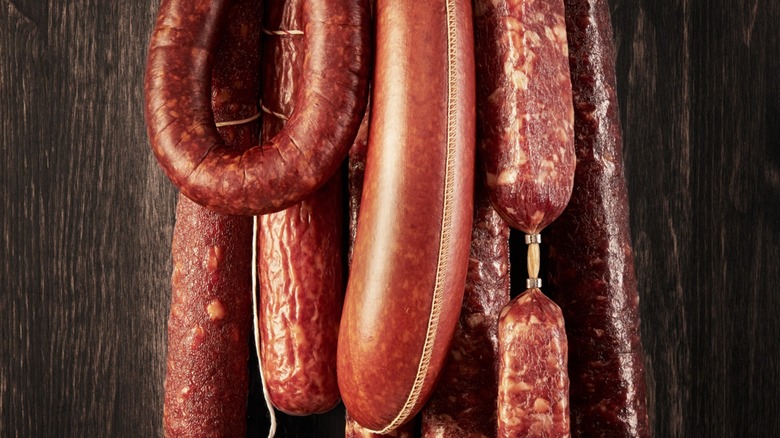What Makes Old World Pepperoni So Unique?
Pepperoni is just one of those ingredients that don't need an introduction — it's iconic, and almost everyone is familiar with it because of its association with pizza. After all, it's America's favorite pizza topping. But did you know there are two distinct styles of pepperoni? On the one hand, there's regular pepperoni, like the type found in any grocery store. This category usually comes presliced and features a characteristic red tint. But the other, known as old-world pepperoni, tends to differ slightly from its counterpart, making it a unique find.
Although the phrasing of this specific style conjures up ideas that imply old-world pepperoni originates from Italy, both types are strictly American, specifically Italian-American, innovations. This is precisely what food writer and historian John Mariani told The New York Times. According to Mariani, pepperoni didn't first appear until 1919, roughly around the time Southern Italian and Sicilian immigrants resettled in the United States. However, that's not to say that old-world pepperoni can't trace its heritage back to European techniques and traditions. That's what makes it different than the pepperoni that most people are acquainted with.
How old world pepperoni differs from regular pepperoni
If you were to go to Italy and ask for a pizza with pepperoni, there's a good chance you would receive one with bell peppers. This is again because pepperoni is a non-Italian pizza topping. Moreover, the term pepperoni in Italy is meant to describe a pepper. As a result, if you want something similar to what you can get in the States, your best bet is to ask for Calabrese salame piccante or spicy salami, pepperoni's Italian equivalent. This is something that chef-restauranteur and one of the authors of "Italian American," Angie Rito (per Bon Appétit), agrees with: "It seems to be most closely related to a Neapolitan- or Calabrese-style dried salami that would have a lot of dried chilies in it." Nevertheless, this is where old-world pepperoni gets its inspiration.
Standard pepperoni is often fermented with lactobacillus bacterial cultures, like cheese or yogurt, and introduced to nitrates. Moreover, it's typically cooked and smoked. This is quite different than traditional Calabrese salami; they are hung to dry and left to their own devices to begin fermentation through contact with yeast and bacteria found naturally in the air, producing that friendly layer of white mold often seen on other salamis. Moreover, these products use natural casings. Incidentally, the last difference makes the old-world style much easier to spot on top of pizza.
How to spot Old-World style pepperoni on a pizza
J. Kenji López-Alt conducted a food experiment to determine why some pepperoni curls where others don't. Although he had multiple theories, one of them revolved around the use of natural casings. This is significant because if that's the case, those crimp little meat discs, which slightly fold up as they cook and cradle their released oils, can be traced back to the older techniques used to make more traditional products like Calabrese salami. Moreover, this curling pepperoni might be something you've already come in contact with.
So, the next time you are out on the town and get a craving to pick up a slice, Instead of getting regular pepperoni, which tends to lay flat, try looking for the ones that are slightly bent on a nice piece of pizza. You might be pleasantly surprised by the difference. After all, the cured, small wheels of meat might be something that more closely resembles traditional Italian salami than the pepperoni you usually pick up in the grocery aisle.


